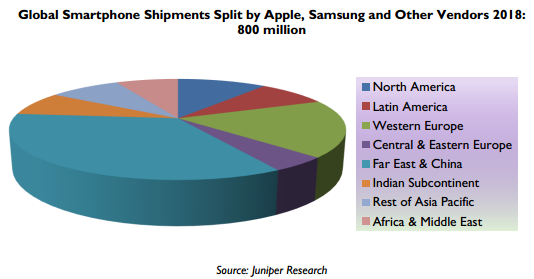The smartphone is now a mainstream mobile communication device in the majority of regions across the globe. For some people, access to the mobile internet enabled their first encounter with the Global Networked Economy.
According to findings from their latest market study, Juniper Research now estimates that the number of smartphone shipments will approach 1.2 billion in 2014 -- that's an increase of 19 percent from the 985 million in 2013.
The global market is expected to be driven by growth in emerging markets, due to a continued surge in sales and adoption of low-cost Economy ($75-$150) and Ultra-Economy (sub-$75) smartphones.
Juniper believes that the emerging markets are now vital to success in the smartphone sector, with the gap between the growing emerging markets and the stagnating mature markets closing.
Emergence of the Low-Cost Smartphones
While Apple and Samsung continue to dominate the Ultra-Premium end of the market, these vendors are facing significant competitive pressure from local players in the emerging markets. For example, Xiaomi, the Chinese smartphone vendor, is witnessing tremendous success in China and India as a result of its aggressive price-point offerings.
These new players are beginning to build market share and achieve larger economies of scale, which eventually will enable them to expand their offering and challenge other smartphone sectors in the future.
Additionally, Google is partnering with local vendors for its Google-One initiative to provide a unified feature set tailor-made for the low-cost smartphone market.
In addition to the recently launched 4.7-inch iPhone 6, Apple launched a larger 5.5-inch iPhone 6 Plus. Although the 5.5-inch smartphone does not strictly classify it as a Phablet, Juniper says that they believe it has the potential to change the dynamics of the phablet market.
These new product introductions could also have a significant impact on other vendors such as Samsung who previously had the additional advantage of having large screen devices. Regardless, Apple will continue to miss opportunities for growth in emerging markets.
Other key findings from the study include:
According to findings from their latest market study, Juniper Research now estimates that the number of smartphone shipments will approach 1.2 billion in 2014 -- that's an increase of 19 percent from the 985 million in 2013.
The global market is expected to be driven by growth in emerging markets, due to a continued surge in sales and adoption of low-cost Economy ($75-$150) and Ultra-Economy (sub-$75) smartphones.
Juniper believes that the emerging markets are now vital to success in the smartphone sector, with the gap between the growing emerging markets and the stagnating mature markets closing.
Emergence of the Low-Cost Smartphones
While Apple and Samsung continue to dominate the Ultra-Premium end of the market, these vendors are facing significant competitive pressure from local players in the emerging markets. For example, Xiaomi, the Chinese smartphone vendor, is witnessing tremendous success in China and India as a result of its aggressive price-point offerings.
These new players are beginning to build market share and achieve larger economies of scale, which eventually will enable them to expand their offering and challenge other smartphone sectors in the future.
Additionally, Google is partnering with local vendors for its Google-One initiative to provide a unified feature set tailor-made for the low-cost smartphone market.
In addition to the recently launched 4.7-inch iPhone 6, Apple launched a larger 5.5-inch iPhone 6 Plus. Although the 5.5-inch smartphone does not strictly classify it as a Phablet, Juniper says that they believe it has the potential to change the dynamics of the phablet market.
These new product introductions could also have a significant impact on other vendors such as Samsung who previously had the additional advantage of having large screen devices. Regardless, Apple will continue to miss opportunities for growth in emerging markets.
Other key findings from the study include:
- Apple and Samsung will account for nearly 45 percent of the global smartphones shipped this year.
- The Average Selling Price of a smartphone will decline globally to reach $274 by 2019.
